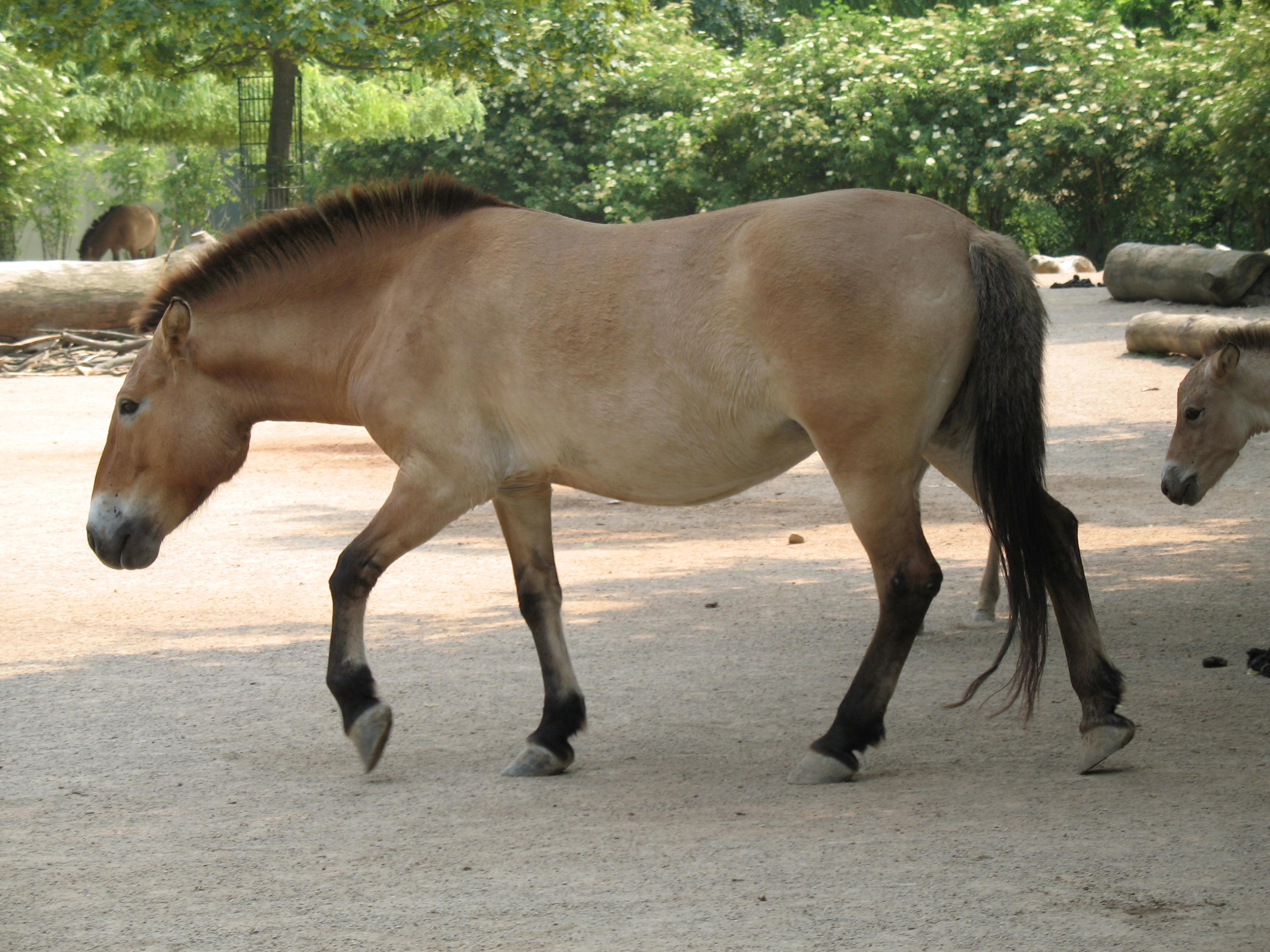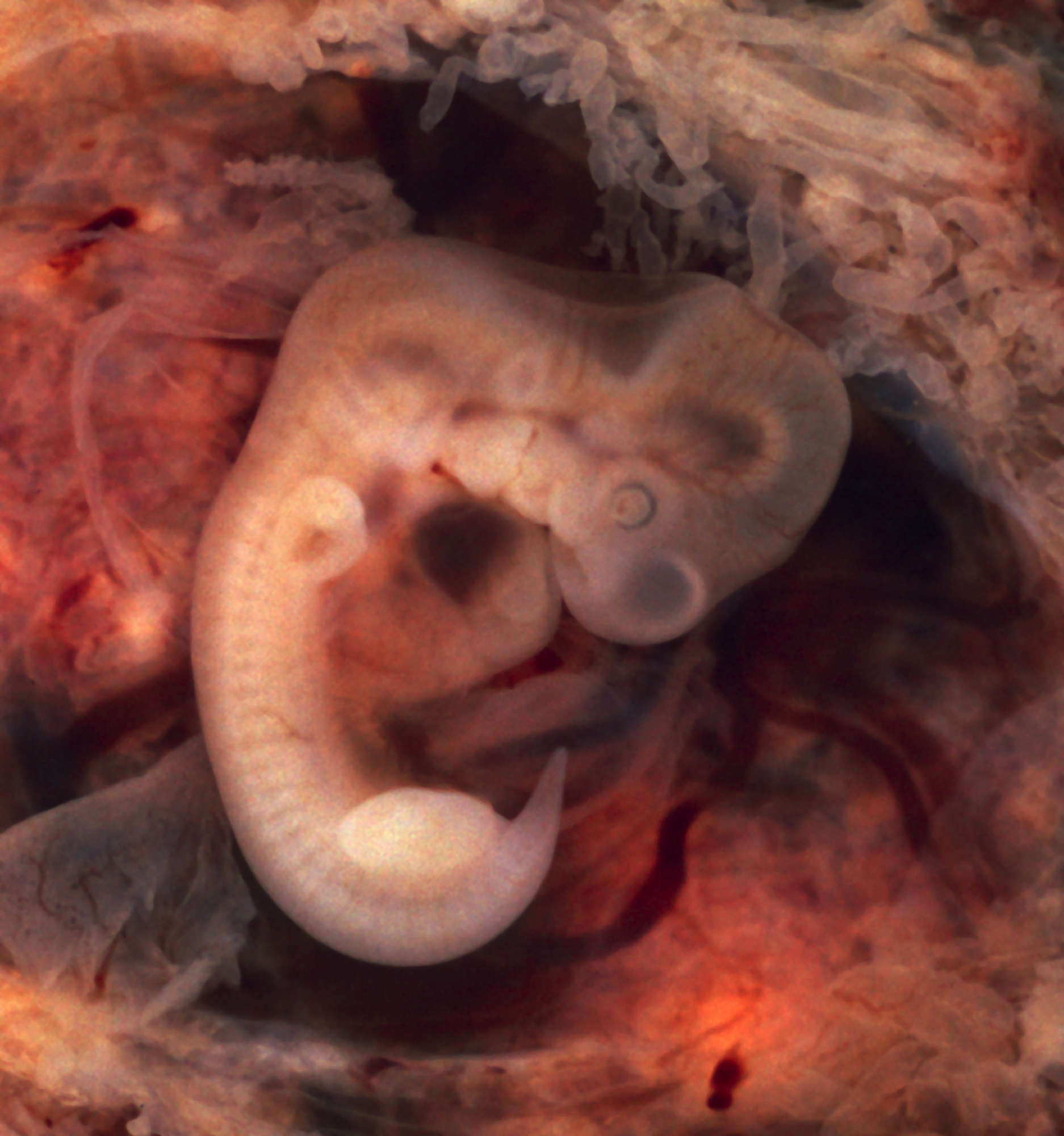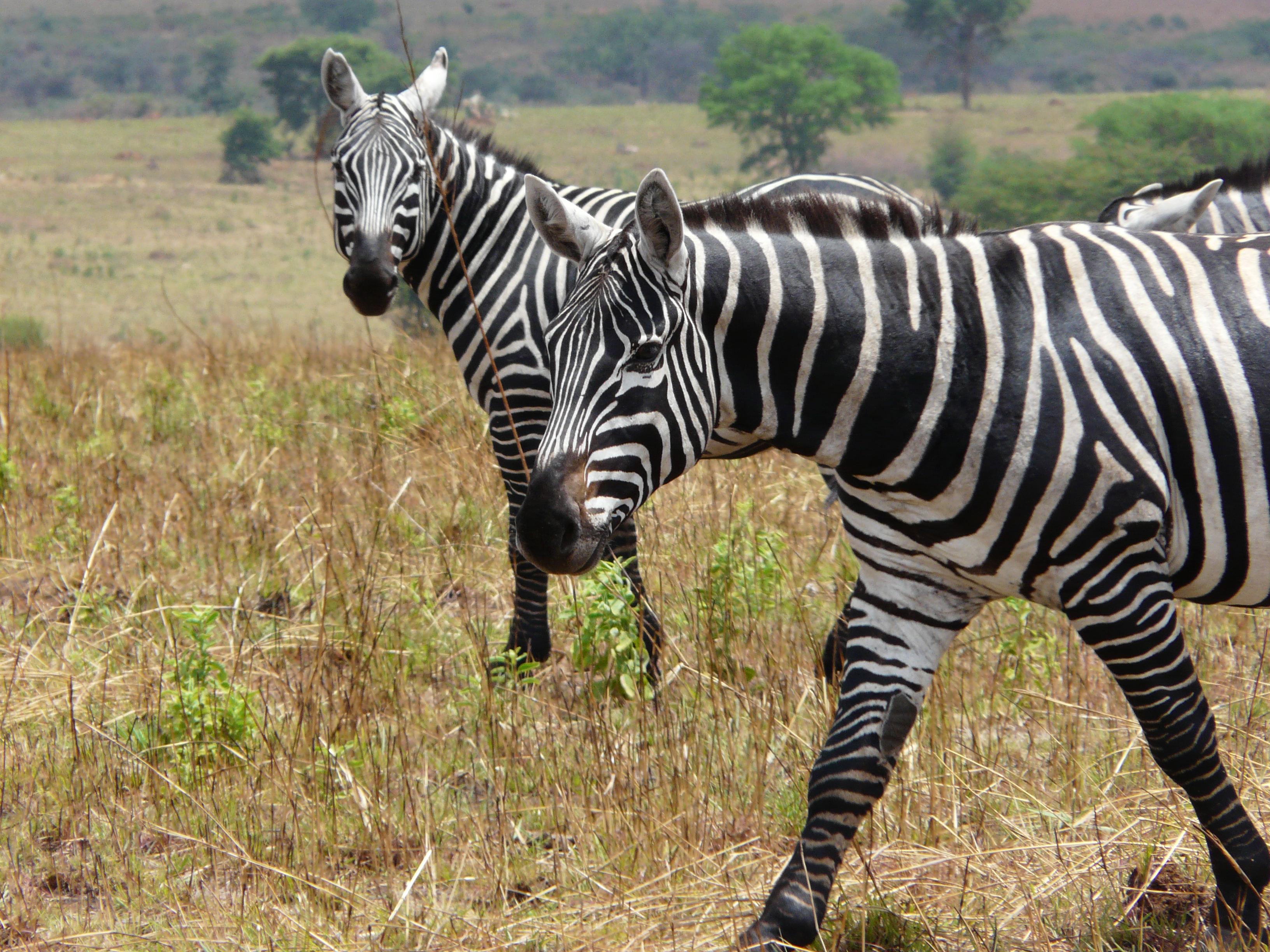|
Primitive Markings
Primitive markings are a group of hair coat markings and qualities seen in several equine species, including horses, donkeys, and asses. In horses, they are associated with primitive breeds, though not limited to such breeds. The markings are particularly associated with the dun coat color family. All dun horses possess at least the dorsal stripe, but the presence of the other primitive markings varies. Other common markings may include horizontal striping on the legs, transverse striping across the shoulders, and lighter guard hairs along the edges of a dark mane and tail. Origin The dun coat and attendant primitive or "dun factor" markings reflect the wild type coat and are observed in all equine species. Some cave paintings depict horses as being dun and with the primitive markings. The Przewalski's horse is dun-colored with primitive markings. So, too, are horse breeds such as the Konik and the Heck horse, "bred back" to resemble the now-extinct tarpan, many of which are ... [...More Info...] [...Related Items...] OR: [Wikipedia] [Google] [Baidu] |
Atavism
In biology, an atavism is a modification of a biological structure whereby an ancestral genetic trait reappears after having been lost through evolutionary change in previous generations. Atavisms can occur in several ways; one of which is when genes for previously existing phenotypic features are preserved in DNA, and these become expressed through a mutation that either knocks out the dominant genes for the new traits or makes the old traits dominate the new one. A number of traits can vary as a result of shortening of the fetal development of a trait (neoteny) or by prolongation of the same. In such a case, a shift in the time a trait is allowed to develop before it is fixed can bring forth an ancestral phenotype. Atavisms are often seen as evidence of evolution. In social sciences, atavism is the tendency of reversion. For example, people in the modern era reverting to the ways of thinking and acting of a former time. The word ''atavism'' is derived from the Latin ''atavus ... [...More Info...] [...Related Items...] OR: [Wikipedia] [Google] [Baidu] |
Palomino
Palomino is a genetic color in horses, consisting of a gold coat and white mane and tail; the degree of whiteness can vary from bright white to yellow. Genetically, the palomino color is created by a single allele of a dilution gene called the cream gene working on a "red" (chestnut) base coat. Palomino is created by a genetic mechanism of incomplete dominance, hence it is not considered true-breeding. However, most color breed registries that record palomino horses were founded before equine coat color genetics were understood as well as they are today, therefore the standard definition of a palomino is based on the visible coat color, not heritability nor the underlying presence of the dilution gene. Due to their distinct color, palominos stand out in a show ring, and are much sought after as parade horses. They were particularly popular in movies and television during the 1940s and 1950s. One of the most famous palomino horses was Trigger, known as "the smartest horse i ... [...More Info...] [...Related Items...] OR: [Wikipedia] [Google] [Baidu] |
Buckskin (horse)
Buckskin is a hair coat color of horses, referring to a color that resembles certain shades of tanned deerskin. Similar colors in some breeds of dogs are also called buckskin. The horse has a tan or gold colored coat with black points (mane, tail, and lower legs). Buckskin occurs as a result of the cream dilution gene acting on a bay horse. Therefore, a buckskin has the Extension, or "black base coat" (E) gene, the agouti gene (A) gene (see bay for more on the agouti gene), which restricts the black base coat to the points, and one copy of the cream gene (CCr), which lightens the red/brown color of the bay coat to a tan/gold. Buckskins should not be confused with dun-colored horses, which have the dun dilution gene, not the cream gene. Duns always have primitive markings (shoulder blade stripes, dorsal stripe, zebra stripes on legs, webbing). However, it is possible for a horse to carry both dilution genes; these are called "buckskin duns" or sometimes "dunskins." Also, ... [...More Info...] [...Related Items...] OR: [Wikipedia] [Google] [Baidu] |
Cream Gene
The cream gene is responsible for a number of horse coat colors. Horses that have the cream gene in addition to a base coat color that is chestnut will become palomino if they are heterozygous, having one copy of the cream gene, or cremello, if they are homozygous. Similarly, horses with a bay base coat and the cream gene will be buckskin or perlino. A black base coat with the cream gene becomes the not-always-recognized smoky black or a smoky cream. Cream horses, even those with blue eyes, are not white horses. Dilution coloring is also not related to any of the white spotting patterns. The cream gene (''CCr'') is an incomplete dominant allele with a distinct dosage effect. The DNA sequence responsible for the cream colors is the cream allele, which is at a specific locus on the solute carrier family 45 member 2 (''SLC45A2'') gene (previously known as ''MATP'' and ''OCA4'', among others). Its general effect is to lighten the coat, skin and eye colors. When one copy ... [...More Info...] [...Related Items...] OR: [Wikipedia] [Google] [Baidu] |
Kiang
The kiang (''Equus kiang'') is the largest of the ''Asinus'' subgenus. It is native to the Tibetan Plateau, where it inhabits montane and alpine grasslands. Its current range is restricted to the plains of the Tibetan plateau; Ladakh; and northern Nepal. Other common names for this species include Tibetan wild ass, khyang and gorkhar. Travellers' accounts of the kiang are one inspiration for the unicorn. Characteristics The kiang is the largest of the wild asses, with an average height at the withers of . They range from high at the withers, with a body long, and a tail of . Kiangs have only slight sexual dimorphism, with the males weighing from , while females weigh . They have a large head, with a blunt muzzle and a convex nose. The mane is upright and relatively short. The coat is a rich chestnut colour, darker brown in winter and a sleek reddish brown in late summer, when the animal moults its woolly fur. The summer coat is 1.5 cm long and the winter coat is doubl ... [...More Info...] [...Related Items...] OR: [Wikipedia] [Google] [Baidu] |
Onager
The onager (; ''Equus hemionus'' ), A new species called the kiang (''E. kiang''), a Tibetan relative, was previously considered to be a subspecies of the onager as ''E. hemionus kiang'', but recent molecular studies indicate it to be a distinct species, having diverged from the closest relative of the Mongolian wild ass's ancestor less than 500,000 years ago. Subspecies Five widely recognized subspecies of the onager include: A sixth possible subspecies, the Gobi khulan (''E. h. luteus'', also called the ''chigetai'' or ''dziggetai'') has been proposed, but may be synonymous with ''E. h. hemionus''. Debates over the taxonomic identity of the onager occurred until 1980. , four living subspecies and one extinct subspecies of the Asiatic wild ass have been recognized. The Persian onager was formerly known as ''Equus onager'', as it was thought to be a distinct species. Characteristics Onagers are the most horse-like of wild asses. They are short-legged compared to horses, an ... [...More Info...] [...Related Items...] OR: [Wikipedia] [Google] [Baidu] |
Plains Zebra
The plains zebra (''Equus quagga'', formerly ''Equus burchellii''), also known as the common zebra, is the most common and geographically widespread species of zebra. Its range is fragmented, but spans much of southern and eastern Africa south of the Sahara. Six or seven subspecies have been recognised, including the extinct quagga which was thought to be a separate species. More recent research supports variations in zebra populations being Cline (biology), clines rather than subspecies. The plains zebra is intermediate in size between the larger Grévy's zebra and the smaller mountain zebra and tends to have broader stripes than both. Great variation in coat patterns exists between clines and individuals. The plain zebra's habitat is generally, but not exclusively, treeless grasslands and savanna woodlands, both tropical and temperate. They generally avoid desert, dense rainforest and permanent wetlands. Zebras are preyed upon by lions and spotted hyenas, Nile crocodiles and, to ... [...More Info...] [...Related Items...] OR: [Wikipedia] [Google] [Baidu] |
African Wild Ass
The African wild ass (''Equus africanus'') or African wild donkey is a wild member of the horse family, Equidae. This species is thought to be the ancestor of the domestic donkey (''Equus asinus''), which is sometimes placed within the same species. They live in the deserts and other arid areas of the Horn of Africa, in Eritrea, Ethiopia and Somalia. It formerly had a wider range north and west into Sudan, Egypt, and Libya. It is Critically Endangered, with about 570 individuals existing in the wild. Description The African wild ass is about tall and weighs approximately . The short, smooth coat is a light grey to fawn colour, fading quickly to white on the undersides and legs. There is a slender, dark dorsal stripe in all subspecies, while in the Nubian wild ass (''E. a. africanus''), as well as the domestic donkey, there is a stripe across the shoulder. The legs of the Somali wild ass (''E. a. somaliensis'') are horizontally striped with black, resembling those of a zebra. O ... [...More Info...] [...Related Items...] OR: [Wikipedia] [Google] [Baidu] |
Melanistic
The term melanism refers to black pigment and is derived from the gr, μελανός. Melanism is the increased development of the dark-colored pigment melanin in the skin or hair. Pseudomelanism, also called abundism, is another variant of pigmentation, identifiable by dark spots or enlarged stripes, which cover a large part of the body of the animal, making it appear melanistic. The morbid deposition of black matter, often of a malignant character causing pigmented tumors, is called melanosis. Adaptation Melanism related to the process of adaptation is called adaptive. Most commonly, dark individuals become fitter to survive and reproduce in their environment as they are better camouflaged. This makes some species less conspicuous to predators, while others, such as leopards, use it as a foraging advantage during night hunting. Typically, adaptive melanism is heritable: A dominant allele, which is entirely or nearly entirely expressed in the phenotype, is responsible for ... [...More Info...] [...Related Items...] OR: [Wikipedia] [Google] [Baidu] |


.jpg)

_from_the_book_entitled%2C_The_great_and_small_game_of_India%2C_Burma%2C_and_Tibet_(1900)_(cropped).jpg)
.jpg)

.jpg)
